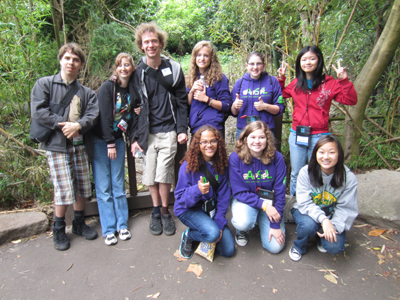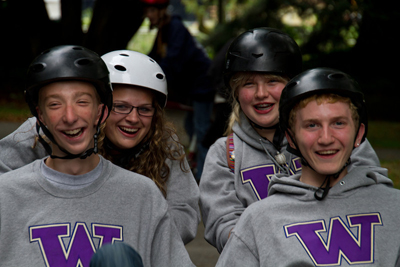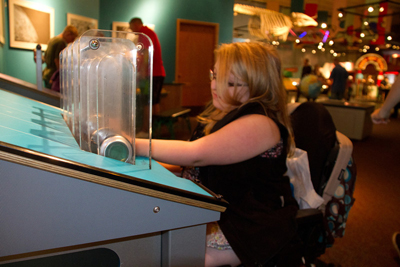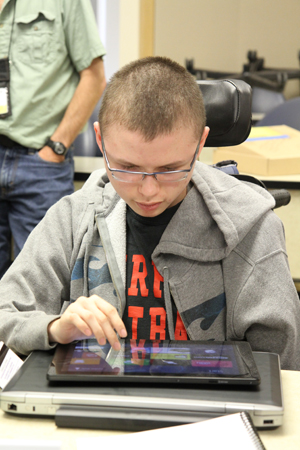Summer Study: What Do Phase I Scholars Do?
The DO-IT Phase I Scholars participate in a two-week, live-in Summer Study session on the UW Seattle campus. They learn about college life; explore the Internet; interact with peers, staff, and mentors; and have fun. DO-IT Scholars program started in 1993 as an experimental project for teens with disabilities nationwide. It is currently open to Washington State teens and is supported by the State of Washington, the Boeing Company, the Microsoft Corporation, and the National Oceanic and Atmospheric Administration.
Accessibility In Review
There are many different ways that programs and buildings can be accessible to people. At Summer Study, we learned how people with disabilities are affected when a place is not accessible to its visitors or a program is not accessible to its participants. We evaluated the accessibility of several buildings and programs.

To start, we evaluated the University of Washington, Seattle campus. Although it has ramps and elevators, it also has large hills. Some ramps are placed in very inconvenient places that take a very long time to get up and down. By the time a person in a wheelchair finally gets up the ramp they may already be separated from the group that was able to walk up the stairs.
The second problem we found was at the planetarium. Visitors who were deaf or blind were at a great loss without interpreters or audio description. People who are deaf could either look at the interpreter to understand what was being said or they could look at the screen and miss the explanation. Those who are blind could only hear what was going on because there was no description for them on what the images looked like.
We also evaluated the Pacific Science Center, Microsoft, Woodland Zoo, and University Village. There were many accessibility barriers for multiple disability types. For people using wheelchairs, there were no ramps at the Science Center's sea urchin tank so these visitors were unable to touch them. Also, some stores at University Village were difficult for people in wheelchairs to navigate. At the zoo, walkways were hilly; we believe it would be simple to level the walkways to increase accessibility. For people with hearing impairments, captioning was not provided for videos at the Science Center. And during a Michael Jackson laser show at the Science Center, it was impossible for people who are deaf to know the songs being played. We did not find audio description for the blind provided for videos at any of the places we visited.
It would be straightforward to add some of the accommodations noted above, such as more ramps and closed captioning. These improvements would increase access to all people, including those with disabilities.
Outdoors for All

Summer Study participants are introduced to lots of different types of technology. One night we learned about many different types of accessible bikes. One bike was operated using hand steering, where you pedal with your hands instead of your feet. Another bike was a two-person tricycle with a backrest that was operated by your feet instead of your arms.
Jennifer used the hand-driven bike because she has cerebral palsy and cannot use her legs to pedal a standard bike. It took some getting used to the hand driven bike, but in time it became very easy to ride. This was her first time riding a bike and it was a wonderful experience.
Allison rode the tricycle. She liked that the bike had a backrest—the tricycle that she owns does not and she found the backrest much more comfortable. The tricycle was also adjustable in almost every way. The seats could shift forward or backward and the handles could move up or down. All around, it was just nice to be able to bike comfortably and safely next to her able-bodied personal care assistant, Taylor.
We were very pleased and impressed by the number of accessible bikes that were available.
IMAX Accessibility
Our experience at the IMAX Theater was great and interesting! We saw Mummies: Secrets of the Pharaohs. We were seated early, which was great for the people in wheelchairs. Also, Scholars who are deaf received the movie script ahead of time, which was helpful because we knew what the movie was going to be about. However, the theater was so dark that the script was unreadable during movie. Captions would have been helpful, whether it be captioning glasses or open captioning on the screen.
The visual aspects of the IMAX movie were awesome! Because of the great visuals, Scholars who are hearing impaired were able to understand what was going on by the actions of the characters in the movie. The sound was also awesome because we could feel the vibrations. This made the movie fun! The movie engaged our curiosity but it was too short, we wanted to know more about the subject. We were glad to have this experience so a big thank you to DO-IT and everyone involved in making the IMAX movie happen.
Pacific Science Center

On Saturday morning, the DO-IT crew went to the Pacific Science Center. We started our visit with the dinosaur exhibit, which was very accessible. We moved towards the butterfly exhibit, also very accessible. Unlike the dinosaur exhibit, this exhibit was very warm. We ate turkey sandwiches for lunch while protecting ourselves from curious birds. We watched an IMAX movie that did not have captions. After exploring the fantastic Science Center some more, we watched a laser show featuring Michael Jackson. It was an excellent laser show, although we wish that the lyrics of the songs were laser-lit. This day was definitely an excellent, inspirational experience.
A Trip to Microsoft

The trip to Microsoft was an exciting hands-on experience. We had the opportunity to work in the role of a product manager and plan out a new playful pet. Learning about the ways that Microsoft accommodates people with disabilities was one of the most important things to us. We appreciated that anyone, even a person with a disability, could have a hands-on experience with something special that would be shipped off to the customer.
Some of the new technology we saw at Microsoft was very cool. It was a good behind-the-scenes look at how the employees of Microsoft are working to make technology accessible for people with disabilities. Microsoft had a scenario room for people with various disabilities. The scenario room had some familiar technology as well as some technology our group had never seen before. For example, there was a scenario where the person couldn't use their arms. They had technology that allowed you to control the mouse with a dot that goes on your head. You move your head and can type and access the computer without your arms. We thought that was pretty cool. It's amazing what people can do with technology.
The trip to Microsoft was intriguing in a variety of ways, from coming up with ideas for a robotic dog to seeing how the Xbox Kinect works. It makes us wonder who came up with the idea for the Kinect and how they did it. It would be very interesting to work at Microsoft developing new software. We would like to go back someday—maybe as interns.
Investigative Interviews
As Phase I Scholars, we learned about all different types of disabilities during our week at Summer Study.
After interviewing fellow Scholar Peter, we found out he has autism. He was diagnosed when he was two and a half years old. He has worked with a therapist. One of his accommodations is he is able to have extended time on his tests at school.
Alicia, another Phase I Scholar, was diagnosed as deaf when she was only one year old. She uses an interpreter and has notes provided by the teachers at school. Alicia also wears not one, but two cochlear implants. A cochlear implant is a surgical device implanted in the cochlear to help people hear better. She found out about the DO-IT program through her older sister, Erika, a Phase II Scholar.
We also interviewed Phase II Scholar Kaylie, who is also deaf. She learned how to prepare for college and the future from DO-IT. She really enjoyed being a Phase II Scholar because of the many interactive hands-on activities.